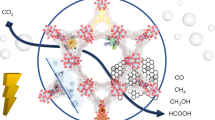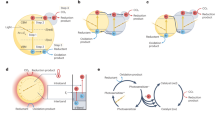Abstract
Visible-light-driven conversion of CO2 to fuels and valuable compounds has experienced tremendous activity in recent years, aiming at storing solar energy into chemical bonds using CO2 as a renewable feedstock, ultimately at massive scale. Despite these efforts, processes and catalytic systems are still at an early stage of development, with fundamental mechanistic challenges as pre-requisites for device design. In this context, collective efforts currently necessitate the exploration of a variety of approaches. On the other hand, an alignment of practices is required to ensure robustness, precision and accuracy of the results, as well as shared metrics and tools for advancing our understanding of the necessary processes. This Perspective aims to provide guidelines and a framework towards these objectives.

This is a preview of subscription content, access via your institution
Access options
Access Nature and 54 other Nature Portfolio journals
Get Nature+, our best-value online-access subscription
$29.99 / 30 days
cancel any time
Subscribe to this journal
Receive 12 digital issues and online access to articles
$119.00 per year
only $9.92 per issue
Buy this article
- Purchase on Springer Link
- Instant access to full article PDF
Prices may be subject to local taxes which are calculated during checkout




Similar content being viewed by others
References
Burdyny, T. & Smith, W. A. CO2 reduction on gas-diffusion electrodes and why catalytic performance must be assessed at commercially-relevant conditions. Energy Environ. Sci. 12, 1442–1453 (2019).
Morikawa, T., Sato, S., Sekizawa, K., Suzuki, T. M. & Arai, T. Solar-driven CO2 reduction using a semiconductor/molecule hybrid photosystem: from photocatalysts to a monolithic artificial leaf. Acc. Chem. Res. 55, 933–943 (2022).
Albero, J., Peng, Y. & García, H. Photocatalytic CO2 reduction to C2+ products. ACS Catal. 10, 5734–5749 (2020).
Wang, Q. & Pan, Z. Advances and challenges in developing cocatalysts for photocatalytic conversion of carbon dioxide to fuels. Nano Res. 15, 10090–10109 (2022).
Bae, K.-L., Kim, J., Lim, C. K., Nam, K. M. & Song, H. Colloidal zinc oxide-copper(I) oxide nanocatalysts for selective aqueous photocatalytic carbon dioxide conversion into methane. Nat. Commun. 8, 1156 (2017).
Wang, Q. et al. Molecularly engineered photocatalyst sheet for scalable solar formate production from carbon dioxide and water. Nat. Energy 5, 703–710 (2020).
Suzuki, T. M. et al. Photocatalytic CO2 reduction by a Z-scheme mechanism in an aqueous suspension of particulate (CuGa)0.3Zn1.4S2, BiVO4 and a Co complex operating dual-functionally as an electron mediator and as a cocatalyst. Appl. Cat. B 316, 121600 (2022).
Sahm, C. D., Ucoski, G. M., Roy, S. & Reisner, E. Automated and continuous-flow platform to analyze semiconductor–metal complex hybrid systems for photocatalytic CO2 reduction. ACS Catal. 11, 11266–11277 (2021).
Alley, O. J. et al. Best practices in PEC water splitting: how to reliably measure solar-to-hydrogen efficiency of photoelectrodes. Front. Energy Res. 10, 884364 (2022).
Rabani, J., Mamane, H., Pousty, D. & Bolton, J. R. Practical chemical actinometry—a review. Photochem. Photobiol. 97, 873–902 (2021).
Hong, J., Zhang, W., Ren, J. & Xu, R. Photocatalytic reduction of CO2: a brief review on product analysis and systematic methods. Anal. Methods 5, 1086–1097 (2013).
Kuhl, K. P., Cave, E. R., Abram, D. N. & Jaramillo, T. F. New insights into the electrochemical reduction of carbon dioxide on metallic copper surfaces. Energy Environ. Sci. 5, 7050–7059 (2012).
Rao, H., Lim, C.-H., Bonin, J., Miyake, G. M. & Robert, M. Visible-light-driven conversion of CO2 to CH4 with an organic sensitizer and an iron porphyrin catalyst. J. Am. Chem. Soc. 140, 17830–17834 (2018).
Yang, C.-C., Yu, Y.-H., van der Linden, B., Wu, J. C. S. & Mul, G. Artificial photosynthesis over crystalline TiO2-based catalysts: fact or fiction? J. Am. Chem. Soc. 132, 8398–8406 (2010).
Boutin, E. et al. Aqueous electrochemical reduction of carbon dioxide and carbon monoxide into methanol with cobalt phthalocyanine. Angew. Chem. Int. Ed. 58, 16172–16176 (2019).
Chatterjee, T., Boutin, E. & Robert, M. Manifesto for the routine use of NMR for the liquid product analysis of aqueous CO2 reduction: from comprehensive chemical shift data to formaldehyde quantification in water. Dalton Trans. 49, 4257–4265 (2020).
Kalathil, S., Miller, M. & Reisner, E. Microbial fermentation of polyethylene terephthalate (PET) plastic waste for the production of chemicals or electricity. Angew. Chem. Int. Ed. 61, e202211057 (2022).
Lam, E. & Reisner, E. A TiO2-Co(terpyridine)2 photocatalyst for the selective oxidation of cellulose to formate coupled to the reduction of CO2 to syngas. Angew. Chem. Int. Ed. 60, 23306–23312 (2021).
Pichler, C. M., Bhattacharjee, S., Rahaman, M., Uekert, T. & Reisner, E. Conversion of polyethylene waste into gaseous hydrocarbons via integrated tandem chemical–photo/electrocatalytic processes. ACS Catal. 11, 9159–9167 (2021).
Kamogawa, K. et al. Mechanistic study of photocatalytic CO2 reduction using a Ru(II)–Re(I) supramolecular photocatalyst. Chem. Sci. 12, 9682–9693 (2021).
Wang, M. et al. CO2 electrochemical catalytic reduction with a highly active cobalt phthalocyanine. Nat. Commun. 10, 3602 (2019).
Costentin, C., Robert, M. & Savéant, J.-M. Catalysis of the electrochemical reduction of carbon dioxide. Chem. Soc. Rev. 42, 2423–2436 (2013).
Costentin, C. & Savéant, J.-M. Cyclic voltammetry of electrocatalytic films: fast catalysis regimes. ChemElectroChem 2, 1774–1784 (2015).
Arakawa, R., Tachiyashiki, S. & Matsuo, T. Detection of reaction intermediates: photosubstitution of (polypyridine)ruthenium(II) complexes using online electrospray mass spectrometry. Anal. Chem. 67, 4133–4138 (1995).
Vogt, C. & Weckhuysen, B. M. The concept of active site in heterogeneous catalysis. Nat. Rev. Chem. 6, 89–111 (2022).
Bo, Y., Gao, C. & Xiong, Y. Recent advances in engineering active sites for photocatalytic CO2 reduction. Nanoscale 12, 12196–12209 (2020).
Perazio, A., Lowe, G., Gobetto, R., Bonin, J. & Robert, M. Light-driven catalytic conversion of CO2 with heterogenized molecular catalysts based on fourth period transition metals. Coord Chem Rev 443, 214018 (2021).
Badiani, V. M. et al. Engineering electro- and photocatalytic carbon materials for CO2 reduction by formate dehydrogenase. J. Am. Chem. Soc. 144, 14207–14216 (2022).
Lee, J.-S. et al. Widely controllable syngas production by a dye-sensitized TiO2 hybrid system with ReI and CoIII catalysts under visible-light irradiation. Angew. Chem. Int. Ed. 56, 976–980 (2017).
Ma, B. et al. Efficient visible-light-driven CO2 reduction by a cobalt molecular catalyst covalently linked to mesoporous carbon nitride. J. Am. Chem. Soc. 142, 6188–6195 (2020).
Ma, B. et al. Hybridization of molecular and graphene materials for CO2 photocatalytic reduction with selectivity control. J. Am. Chem. Soc. 143, 8414–8425 (2021).
Kuehnel, M. F., Orchard, K. L., Dalle, K. E. & Reisner, E. Selective photocatalytic CO2 reduction in water through anchoring of a molecular Ni catalyst on CdS nanocrystals. J. Am. Chem. Soc. 139, 7217–7223 (2017).
Kuehnel, M. F. et al. ZnSe quantum dots modified with a Ni(cyclam) catalyst for efficient visible-light driven CO2 reduction in water. Chem. Sci. 9, 2501–2509 (2018).
Mialane, P. et al. Heterogenisation of polyoxometalates and other metal-based complexes in metal–organic frameworks: from synthesis to characterisation and applications in catalysis. Chem. Soc. Rev. 50, 6152–6220 (2021).
He, Z. et al. Review on covalent organic frameworks and derivatives for electrochemical and photocatalytic CO2 reduction. Catal. Today 409, 103–118 (2023).
Nakada, A., Kumagai, H., Robert, M., Ishitani, O. & Maeda, K. Molecule/semiconductor hybrid materials for visible-light CO2 reduction: design principles and interfacial engineering. Acc. Mater. Res. 2, 458–470 (2021).
Kuramochi, Y. & Ishitani, O. Iridium(III) 1-phenylisoquinoline complexes as a photosensitizer for photocatalytic CO2 reduction: a mixed system with a Re(I) catalyst and a supramolecular photocatalyst. Inorg. Chem. 55, 5702–5709 (2016).
Takeda, H., Koike, K., Inoue, H. & Ishitani, O. Development of an efficient photocatalytic system for CO2 reduction using rhenium(I) complexes based on mechanistic studies. J. Am. Chem. Soc. 130, 2023–2031 (2008).
Chernyshev, V. M. et al. Pd and Pt catalyst poisoning in the study of reaction mechanisms: what does the mercury test mean for catalysis? ACS Catal. 9, 2984–2995 (2019).
Takeda, H., Koizumi, H., Okamoto, K. & Ishitani, O. Photocatalytic CO2 reduction using a Mn complex as a catalyst. Chem. Commun. 50, 1491–1493 (2014).
Fu, J., Jiang, K., Qiu, X., Yu, J. & Liu, M. Product selectivity of photocatalytic CO2 reduction reactions. Mater. Today 32, 222–243 (2020).
Yamazaki, Y., Takeda, H. & Ishitani, O. Photocatalytic reduction of CO2 using metal complexes. J. Photochem. Photobio. C 25, 106–137 (2015).
Sun, H. (ed.) Solar-to-Chemical Conversion: Photocatalytic and Photoelectrochemical Processes (Wiley-VCH, 2021).
Miao, T. J. & Tang, J. Characterization of charge carrier behavior in photocatalysis using transient absorption spectroscopy. J. Chem. Phys. 152, 194201 (2020).
Paz, Y. Transient IR spectroscopy as a tool for studying photocatalytic materials. J. Condens. Matter Phys. 31, 503004 (2019).
Bracci, M. et al. in Electron Paramagnetic Resonance Vol. 27 (eds Murphy D. M. et al.) 1–46 (Royal Society of Chemistry, 2021).
Hess, C. New advances in using Raman spectroscopy for the characterization of catalysts and catalytic reactions. Chem. Soc. Rev. 50, 3519–3564 (2021).
Rotundo, L. et al. Photochemical CO2 reduction using rhenium(I) tricarbonyl complexes with bipyridyl-type ligands with and without second coordination sphere effects. ChemPhotoChem 5, 526–537 (2021).
Clark, M. L. et al. CO2 reduction catalysts on gold electrode surfaces influenced by large electric fields. J. Am. Chem. Soc. 140, 17643–17655 (2018).
Chen, L. D., Urushihara, M., Chan, K. & Nørskov, J. K. Electric field effects in electrochemical CO2 reduction. ACS Catal. 6, 7133–7139 (2016).
Liu, M. et al. Enhanced electrocatalytic CO2 reduction via field-induced reagent concentration. Nature 537, 382–386 (2016).
Fujita, E., Grills, D. C., Manbeck, G. F. & Polyansky, D. E. Understanding the role of inter- and intramolecular promoters in electro- and photochemical CO2 reduction using Mn, Re, and Ru catalysts. Acc. Chem. Res. 55, 616–628 (2022).
Acknowledgements
D.S., M.R. and J.B. acknowledge funding (ANR-20-CE05-0019) received from Agence Nationale de la Recherche. M.R. acknowledges partial financial support from Institut Universitaire de France. E.R. acknowledges a consolidator grant (MatEnSAP, 682833) from the European Research Council. A.J.M. acknowledges support from the Department of Energy, Office of Basic Energy Sciences, under grant DE-SC0012446. M.B. acknowledges a European Commission grant (DECADE, H2020-RIA-CE-NMBP-25 Program, grant no. 862030). T.-B.L. acknowledges support from the National Natural Science Foundation of China (21931007) and the National Key R&D Program of China (2022YFA1502902). O.I. acknowledges a Japan Society for the Promotion of Science KAKENHI grant (JP17H06440) in Scientific Research on Innovative Areas ‘Innovations for Light-Energy Conversion (I4LEC)’. F.M.T. acknowledges support from the Liquid Sunlight Alliance, which is supported by the US Department of Energy, Office of Science, Office of Basic Energy Sciences, Fuels from Sunlight Hub under award no. DE-SC0021266.
Author information
Authors and Affiliations
Contributions
J.B. and M.R. built up the article based on the contribution of all the authors on specific sections, who also contributed to the discussion, reviewing and editing of the manuscript.
Corresponding authors
Ethics declarations
Competing interests
The authors declare no competing interests.
Peer review
Peer review information
Nature Catalysis thanks Jingrun Ran and the other, anonymous, reviewer(s) for their contribution to the peer review of this work.
Additional information
Publisher’s note Springer Nature remains neutral with regard to jurisdictional claims in published maps and institutional affiliations.
Rights and permissions
Springer Nature or its licensor (e.g. a society or other partner) holds exclusive rights to this article under a publishing agreement with the author(s) or other rightsholder(s); author self-archiving of the accepted manuscript version of this article is solely governed by the terms of such publishing agreement and applicable law.
About this article
Cite this article
Bonchio, M., Bonin, J., Ishitani, O. et al. Best practices for experiments and reporting in photocatalytic CO2 reduction. Nat Catal 6, 657–665 (2023). https://doi.org/10.1038/s41929-023-00992-7
Received:
Accepted:
Published:
Issue Date:
DOI: https://doi.org/10.1038/s41929-023-00992-7
This article is cited by
-
Photocatalytic reduction of CO2 with H2O into C2H6 mediated by dual metalation strategy
Science China Chemistry (2023)



